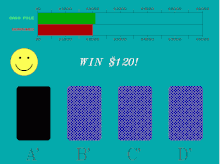Antonio Damasio Gambling Experiment
The Iowa gambling task is a psychological task thought to simulate real-life
Participants are presented with 4 virtual decks of cards on a computer screen. They are told that each time they choose a card they will win some game money. Every so often, however, choosing a card causes them to lose some money. The goal of the game is to win as much money as possible. Every card drawn will earn the participant a reward. Occasionally, a card will also have a penalty. Thus, some decks are 'bad decks', and other decks are 'good decks', because some will lead to losses over the long run, and others will lead to gains. The decks differ from each other in the number of trials over which the losses are distributed.
Antonio Damasio Bernard Renault In a MEG experiment, we imaged the early dynamics of the human cerebral cortex during the induction of emotion by visual stimuli. This led Damasio to formulate what might be his great contribution to the understanding of the brain (and the human body): what he calls the somatic (as in body) marker hypothesis. Essentially, he reasons, when you’re thinking about a course of action, you imagine your body to be in the potential situation, and you get, in layman’s terms, a. One way Damasio demonstrated the effects of somatic markers was through the Iowa gambling task (e.g., Bechara, Damasio, Damasio, & Anderson, 1994). In this task, participants are presented with four decks of cards and instructed to choose a card from any of the decks. And later on, commenting on Damasio’s interpretation of the gambling experiments: Once again, going by one’s gut feelings is not the only way to cut through the maze of a complex decision 1(Elster 1999),p. FLAIRS 2003 303. The answer is no, and to show why, Shiv, Damasio, and others followed up the original gambling study with an interesting variation. In their experiment, participants repeatedly chose between.
Most healthy participants sample cards from each deck, and after about 40 or 50 selections are fairly good at sticking to the good decks. Patients with
Critiques of the Iowa Gambling Task
Although the IGT has achieved prominence, it is not without its critics. Criticisms have been raised over both its design and its interpretation. Published critiques include:
* A paper by Dunn, Dalgliesh and Lawrence [http://www.ncbi.nlm.nih.gov/entrez/query.fcgi?db=pubmed&cmd=Retrieve&dopt=AbstractPlus&list_uids=16197997&query_hl=17&itool=pubmed_docsum]
* Research by Lin, Chiu, Lee and Hsieh [http://www.ncbi.nlm.nih.gov/entrez/query.fcgi?db=pubmed&cmd=Retrieve&dopt=AbstractPlus&list_uids=17362508&query_hl=2&itool=pubmed_docsum] , who argue that a common result (the “prominent deck B” phenomenon) argues against some of the interpretations that the IGT has been claimed to support.
* Research by Chiu and Lin [http://www.behavioralandbrainfunctions.com/content/3/1/37] , the “sunken deck C” phenomenon was identified, which confirmed a serious confounding embedded in the original design of IGT, this confounding makes IGT serial studies misinterpret the effect of gain-loss frequency as final-outcome for Somatic marker hypothesis.
* A research group in Taiwan utilized an IGT-modified and relatively symmetrical gamble for gain-loss frequency and long-term outcome, namely the Soochow Gambling Task (SGT) [http://www.behavioralandbrainfunctions.com/content/4/1/13] demonstrated a reverse finding of Iowa Gambling Task. Normal decision makers in SGT were mostly occupied by the immediate perspective of gain-loss and inability to hunch the long-term outcome in the standard procedure of IGT (100 trials under uncertainty). Richard Peterson [http://www.marketpsych.com/blog/2006/10/neuroeconomics-2006-book-large-cap.html] [http://www.marketpsych.com/blog/2007/10/neuroeconomics-2007-happenings-at-sfn.html] in his book, Inside the investor’s brain [http://www.amazon.com/dp/0470067373] , considered the serial findings of SGT may be congruent with the Nassim Taleb’s [http://www.fooledbyrandomness.com/] suggestion on some fooled choices in investment.
References
* Bechara A, Damasio AR, Damasio H, Anderson SW (1994). 'Insensitivity to future consequences following damage to human prefrontal cortex', 'Cognition' 50: 7-15.
External links
Antonio Damasio Gambling Experiment Stories

Antonio Damasio Gambling Experiments
*A free implementation of the Iowa Gambling task is available as part of the [http://pebl.sourceforge.net PEBL Project] [http://pebl.sourceforge.net/cgi-bin/moin.cgi/User-Contributed_Experiments/Iowa_Gambling_Task]
*Another, web based, implementation that will also run as a standalone application is available [http://users.fmg.uva.nl/rgrasman/jscript/2005/09/iowa-gambling-task.html here] .
*An Italian implementation is available [http://www.mondoxsardegna.it/igt.php here] .